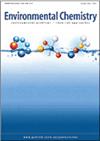Plasticisers in the terrestrial environment: sources, occurrence and fate
IF 2.3
4区 环境科学与生态学
Q3 CHEMISTRY, ANALYTICAL
引用次数: 18
Abstract
Environmental context. Many human activities cause the release of plastic and associated plasticisers to land, where chemicals may persist for extended periods and be taken up by organisms. However, quantitative information of the terrestrial occurrence, fate and exposure of phthalate and non-phthalate plasticisers is lacking. Research into this field is needed, especially as society moves away from phthalates to the next generation of plasticisers which may themselves represent an emerging risk. Abstract. Modern society is widely dependent upon plastic. Therefore, it is unsurprising that macro- and microplastic pollution is found in every environmental compartment on earth. Plasticisers are chemicals added to plastics to increase their flexibility. Like plastics themselves, plasticisers are also widely present in the environment. Plasticisers and plastic debris may undergo long-range transport in the atmosphere and the oceans, contaminating even the most remote areas of land. In addition, although plasticisers typically degrade in a matter of weeks–months, they can persist in soil for decades and have been shown to occur in all land uses studied. Some plasticisers are genotoxic and can be taken up by soil organisms, which may pose a risk to ecosystems and human health. To date the majority of data on plasticisers exists for phthalates. However, plasticisers are a diverse range of chemicals and with the increasing transfer to non-phthalate alternatives, research into the fate and effects of emerging plasticisers is required to determine their environmental risk and management options. Data on the occurrence and ecotoxicity of emerging plasticisers, in addition to the impacts of all plasticisers on terrestrial ecosystems, therefore, remain a key research need within the wider plastics debate. in the global fate and behaviour of persistent organic pollutants and chemicals management. Dr M. Glo´ria Pereira is the Head of the Centralised Chemistry Laboratories at UKCEH and the Head of the NEIF Lancaster Node. The team comprises 17 environmental chemists who carry out metals, nutrients, isotopes and organic analyses and the labs have ISO17025:2017 accreditation. Her research focuses on persistent organic pollutants at environmental levels as well as the identification of emerging compounds that can pose a risk to the environment, wildlife and humans.陆地环境中的增塑剂:来源、发生和命运
环境背景。许多人类活动导致塑料和相关的增塑剂释放到陆地上,这些化学物质可能会在陆地上存留很长时间并被生物吸收。然而,缺乏关于邻苯二甲酸酯和非邻苯二甲酸酯增塑剂在陆地上的发生、命运和暴露的定量信息。这一领域的研究是有必要的,特别是当社会从邻苯二甲酸盐转向下一代增塑剂时,这些增塑剂本身可能代表着一种新的风险。摘要现代社会广泛依赖塑料。因此,在地球上的每个环境隔间中都发现宏观和微观塑料污染也就不足为奇了。增塑剂是添加到塑料中以增加其柔韧性的化学物质。就像塑料本身一样,增塑剂也广泛存在于环境中。增塑剂和塑料碎片可能在大气和海洋中进行远距离运输,甚至污染最偏远的陆地地区。此外,尽管增塑剂通常在几周到几个月的时间内降解,但它们可以在土壤中持续存在数十年,并且已被证明在所有研究过的土地使用中都会出现。一些增塑剂具有遗传毒性,可被土壤生物吸收,这可能对生态系统和人类健康构成风险。迄今为止,关于增塑剂的大部分数据都是关于邻苯二甲酸盐的。然而,增塑剂是多种多样的化学品,随着向非邻苯二甲酸盐替代品的转移越来越多,需要对新兴增塑剂的命运和影响进行研究,以确定其环境风险和管理方案。因此,关于新兴增塑剂的发生和生态毒性的数据,以及所有增塑剂对陆地生态系统的影响,仍然是更广泛的塑料辩论中的一个关键研究需求。在全球的命运和行为的持久性有机污染物和化学品管理。M. Glo´ria Pereira博士是UKCEH中央化学实验室的负责人,也是NEIF兰开斯特节点的负责人。该团队由17名环境化学家组成,他们进行金属、营养物质、同位素和有机分析,实验室通过了ISO17025:2017认证。她的研究重点是环境层面的持久性有机污染物,以及可能对环境、野生动物和人类构成风险的新兴化合物的识别。
本文章由计算机程序翻译,如有差异,请以英文原文为准。
求助全文
约1分钟内获得全文
求助全文
来源期刊

Environmental Chemistry
环境科学-分析化学
CiteScore
4.50
自引率
0.00%
发文量
0
审稿时长
2.7 months
期刊介绍:
Environmental Chemistry publishes manuscripts addressing the chemistry of the environment (air, water, earth, and biota), including the behaviour and impacts of contaminants and other anthropogenic disturbances. The scope encompasses atmospheric chemistry, geochemistry and biogeochemistry, climate change, marine and freshwater chemistry, polar chemistry, fire chemistry, soil and sediment chemistry, and chemical aspects of ecotoxicology. Papers that take an interdisciplinary approach, while advancing our understanding of the linkages between chemistry and physical or biological processes, are particularly encouraged.
While focusing on the publication of important original research and timely reviews, the journal also publishes essays and opinion pieces on issues of importance to environmental scientists, such as policy and funding.
Papers should be written in a style that is accessible to those outside the field, as the readership will include - in addition to chemists - biologists, toxicologists, soil scientists, and workers from government and industrial institutions. All manuscripts are rigorously peer-reviewed and professionally copy-edited.
Environmental Chemistry is published with the endorsement of the Commonwealth Scientific and Industrial Research Organisation (CSIRO) and the Australian Academy of Science.
 求助内容:
求助内容: 应助结果提醒方式:
应助结果提醒方式:


